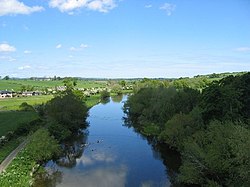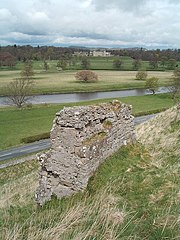Roxburgh
| Roxburgh | |
| Roxburghshire | |
|---|---|
 The Teviot and Roxburgh | |
| Location | |
| Grid reference: | NT713337 |
| Location: | 55°35’47"N, 2°27’22"W |
| Data | |
| Population: | 419 (2001) |
| Post town: | Kelso |
| Postcode: | TD5 |
| Dialling code: | 01573 |
| Local Government | |
| Council: | Scottish Borders |
| Parliamentary constituency: |
Berwickshire, Roxburgh and Selkirk |
Roxburgh in Roxburghshire is found on the narrow tongue of land between the Rivers Teviot and Tweed, which meet at Kelso. The name belongs both to a destroyed town at the meeting of the rivers and to a small village a little upstream.
Roxburgh was a royal burgh, an important trading burgh in High Middle Ages and into the early modern period. In the Middle Ages it had at least as much importance as Edinburgh, Stirling, Perth, or Berwick-upon-Tweed, for a time acting as the capital of Scotland, as royal residence of King David I. Its strategic importance though was too great and the constant fratricidal wars of the Middle Ages raged through Roxburgh until it was destroyed in 1460. The modern village lies a little upstream.
Name of the town
Roxburgh probably comes from Old English hrocas burh, "rook's borough" or "Hroc's town" after an unknown founder.[1]
The name was originally applied to the town and castle in the sharp corner at the meeting of the Tweed and the Teviot. That site having been destroyed, the name has been inherited by its village.
Roxburgh Village

Roxburgh is today a village off the A699, on the north bank of the River Teviot, near Kelso. Its farmland reaches north to the Tweed. It stands two miles upstream of Old Roxburgh.
The Borders Abbeys Way passes through the village.
The village was first created as a dependent settlement of the burgh of Roxburgh, which had become too full to fit all of its population. It later years, when Old Roxburgh was destroyed, the village upstream became the sole bearer of its namr. It is not the burgh from which the fair Shire of Roxburgh is named, but it is the lawful heir of that vanished town.
Old Roxburgh

When Old Roxburgh as founded cannot be said for sure, but it is presumed to have been a fortified site in the Anglo-Saxon period, as its name would suggest. In the tenth or twelfth century, the lands north of the Tweed, known as Lothian, were ceded by the King of the English to the King of the Scots, though Roxburgh is later described as lying on the border.
Roxburgh became an important castle site in the Middle Ages. Its significance lay in its position in the centre of some of Lowland Scotland's most agriculturally fertile areas, and its position upon the River Tweed, which allowed river transport of goods by way of the main seaport of Berwick-upon-Tweed. The town stood on a defensible peninsula between the rivers Tweed and Teviot, with Roxburgh Castle guarding the narrow neck of the peninsula.
The castle was founded by King David I. English and Scots forces repeatedly captured and recaptured the town during the Scottish Wars of Independence and the further wars provoked by the Auld Alliance between Scotland and France. It was first surrendered to England in 1174 after the capture of William I at Alnwick, but in 1189 Richard I returned Roxburgh and Berwick to King William by the Quitclaim of Canterbury. Nevertheless, the castle was often in English hands thereafter. The Scots made many attempts to regain the fortress. In 1314 it was retaken by Sir James Douglas, but was later lost again. Henry V of England made repairs to the castle after a Scottish siege in 1417.
The last battle was the capture of the casle by King James II of Scotland in 1460. The King was killed whilst bombarding the castle, when one of his own cannons exploded. However Roxburgh was stormed, and James' queen Mary of Guelders had the castle demolished.
After this, the town never regained its importance because the final English capture of Berwick-upon-Tweed in 1482 left Roxburgh with little reason to exist. Roxburgh was superseded as the county town of Roxburghshire by Jedburgh and vanished.
In 1545, during the Rough Wooing, the English garrison commanded by Ralph Bulmer built a rectangular fort on the site at the instigation of the Earl of Hertford. This was destroyed in 1550 by the terms of the Treaty of Boulogne.
Nothing remains of the town today except a large mound, with some ruined segments of castle ramparts. The Duke of Roxburghe owns the site, part of his estate of attached to his seat, Floors Castle. Floors Castle itself stands on the other side of the Tweed.
Poplar culture
The main claim of Roxburgh today is having named Roxburghshire.
In his books The Borders and Arthur & the Lost Kingdoms, Alistair Moffat argues that an ancient fort on the site of Roxburgh Castle was Camelot.
The capture of the castle in 1314 is one of the inspirations of "The Three Perils of Man" by James Hogg.
Outside links

- RCAHMS record of Roxburgh Parish Church, Churchyard
- Geograph image of Roxburgh from the Viaduct, with the River Teviot
- CANMORE/RCAHMS record of Roxburgh Castle; Old Roxburgh Castle; Protector Somerset's Camp
References
Books
- Coventry, Martin (2006). The Castles of Scotland. Birlinn. ISBN 1-84158-449-5.
- Mike Salter (1985). Discovering Scottish Castles. Shire Publications Ltd. pp. 17–18. ISBN 0-85263-749-7.
- Sadler, John, Border Fury - England and Scotland at War, 1296-1568. Pearson/Longman 2005